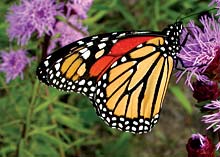The other night I noticed that not only were the fireflies generally absent, but we also have a distinct shortage of mosquitoes, the large garden spiders, my yearly underground hive of yellow jackets, and even many of the butterflies we typically see.

The drought and the earlier freeze are probably to blame for all this. In early to mid-September, we will usually find monarchs, viceroys, admirals and even the cabbage butterflies hovering about the blooming weeds in the fields, not to mention the plants in containers on our terrace.
Out by the road, there’s a reasonably large common milkweed that’s blooming—well, maybe not to beat the band, but it does have some flowers. Yet we haven’t seen a single butterfly come by.
Milkweed’s scientific name, Asclepias syriaca, honors the mythic Greek physician Asclepius, son of Apollo and Coronis. When Asclepius became so proficient in healing that he could actually revive the dead, Zeus killed him. (Imagine if he worked for an HMO.) Competition has its limits, after all. As for the species name, it reflects the famed botanist Linnaeus’ mistaken belief that the plant originally came from Syria.
Although the milkweed flowers are heavy with scent, it’s a bit too strong to be used as a perfume base. The bright-orange color and floral odor do a great deal to ensure pollination, however. In fact, when it comes to fertilization, even the sometimes Machiavellian adaptations of the orchid family may take a back seat to milkweed blossoms. If you sit quietly and watch these flowers on a sunny afternoon, you may be in for a great show provided by the many insects out looking for food. Besides butterflies, the milkweed flowers also attract wasps, flies, beetles and bees.
Upon arrival, those insect visitors soon discover that the flower’s surface is very slick; trying to gain a foothold, they begin clawing about. But all this activity is part of a master plan. As the insects struggle, one or two of the sharp projections on their feet will catch in little clefts at the flower’s base. Soon a foot is drawn into a slot, at the end of which sits a little, dark-brown device that holds masses of yellow pollen.
The pollen container is very hard and has a notch in its face that hooks itself to an insect’s feet. When a bee or fly gives that final tug needed to free itself, the container tags along, now firmly attached. And when the insect lands on another flower, the transported pollen goes through the new slot and fertilizes it.
This doesn’t always work to the insect’s advantage, however. When examining milkweed flowers, you’ll often find smaller insects that simply weren’t able to escape!
Unfortunately for local nature lovers, the wasps and a few bees are still around this year, but the butterflies have mostly flown farther afield.
[Peter Loewer, aka The Wild Gardener, lives in Asheville.]



This was a bad year for butterflies? I can’t wait till next year then. There have been tons of them up at a mountaintop meadow. The Spicebush Swallowtails peaked in early August and there were several dozen at a time. The Monarchs have begun to make their appearance, first a few loners now more every day. There are Skippers, Sulfers, and Tiger Swallowtails. This is just some of what I have noticed without taking a real inventory.
I came from an island that was a bit Butterfly deprived so what I have seen this summer has been spectacular for me.